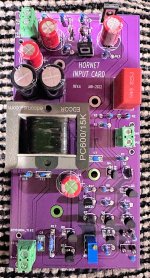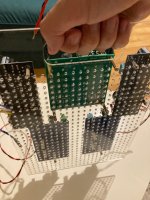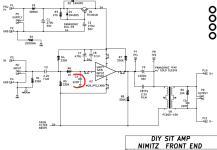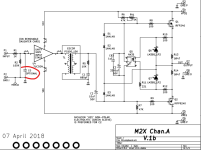Hornet, redux
I've been listening continuously to my (weird! unconventional!) Ship of Theseus with a variety of listening material since I put it in my system a few weeks ago. Today I'm listening to the White Stripes Der Stijl on CD, and the chunk of overdriven guitar comes through almost as if I'm listening to the studio monitors direct. If you're going to go through the trouble of building a Ship of whatever flavor, strongly consider building Hornet cards, even if they're a pain. The thrust and clarity is amazing.
I've been listening continuously to my (weird! unconventional!) Ship of Theseus with a variety of listening material since I put it in my system a few weeks ago. Today I'm listening to the White Stripes Der Stijl on CD, and the chunk of overdriven guitar comes through almost as if I'm listening to the studio monitors direct. If you're going to go through the trouble of building a Ship of whatever flavor, strongly consider building Hornet cards, even if they're a pain. The thrust and clarity is amazing.
The Hornet input card is actually easy to stuff and solder -- components are pleasantly spaced, comfortably apart from each other, and it's not difficult to assemble. But you do need to measure (test) a few of the TO-92s before approving them for Hornet use. Think of this as the Pre Olympic Trials -- winnowing out only the best of the best.
_
_
Attachments
I apologize in advance because I have not read this thread past the first couple of pages…but is there a flow chart or master guide that explains how to pick the right lego pieces for a particular application?
It’s OK to send me back to reading, but if such a thing exists, I would love to start with it…
It’s OK to send me back to reading, but if such a thing exists, I would love to start with it…
Hi
Might be mistaken but i don't think it exists.
From the initial description
1. you have an M2x or you want to use the M2x-developped input daughter cards (IPS6, IP7S, Cedarbug,.... example https://www.diyaudio.com/community/threads/the-diyaudio-first-watt-m2x.321925/post-6316096) = Nimitz
2. you have balanced inputs = Missouri
3. few parts & modest costs for those = Pequod.
4. don't want Edcor transformer / can not buy = Lexington
5. check BOM components availability depending on your build timing / goals
Outside of this: reading and assessing the description from the members building the modules...
Personnaly: Option 1, wanting to put the cards in an "easy to access configuration" to be able to swap them relatively quickly.
Just my 2 cents (really that low 'cos it is in the initial description...😏)
Might be mistaken but i don't think it exists.
From the initial description
1. you have an M2x or you want to use the M2x-developped input daughter cards (IPS6, IP7S, Cedarbug,.... example https://www.diyaudio.com/community/threads/the-diyaudio-first-watt-m2x.321925/post-6316096) = Nimitz
2. you have balanced inputs = Missouri
3. few parts & modest costs for those = Pequod.
4. don't want Edcor transformer / can not buy = Lexington
5. check BOM components availability depending on your build timing / goals
Outside of this: reading and assessing the description from the members building the modules...
Personnaly: Option 1, wanting to put the cards in an "easy to access configuration" to be able to swap them relatively quickly.
Just my 2 cents (really that low 'cos it is in the initial description...😏)
Last edited:
Does anyone have a comparison for
Kitty hawk
Hornet
Bon homme richard
Would like to build one of them.
Kitty hawk
Hornet
Bon homme richard
Would like to build one of them.
@ElArte There isn’t a chart like you mention that I know of, but it would be pretty easy to put one together.
The short version would be:
1) DC power
Linear supply or SMPS, 36VDC required. (Single voltage, not bipolar.) With SMPS you could use an external laptop-style brick or an internally mounted open frame. Whatever sounds fun. A linear supply with a transformer and capacitor bank is also an option.
2) DC filter / Anti-thumper
Theseus DC Filter and or Nelson’s filter have PSU filtration (aimed at eliminating the high-frequency stuff that switchers have) as well as a speaker relay that protects your speakers from power on/off transients. Those power thumps are pretty big, so having protection is strongly recommended. (Regardless of linear or SMPS)
3) Front End
So many to chose from, all amazing. My suggestion is get the one(s) that are the most interesting to you. They all sound fantastic. Want a starting suggestion? Kitty Hawk (because it’s an amazing circuit) and Pequod, because rolling opamps is a lot of fun. But any and all work and are worth trying. Also remember that the “vfet front-ends”,named Scourge, Dreadnaught, Marauder, Bulwark, and another one or two where the name is escaping me, are 100% compatible with the Theseus output stage.
4) Output stage
Choose Theseus Mos output stage or one of the Sony Vfet stages IF you happen to have your own Vfet laying around.
Put it all together and enjoy the music! It’s an incredible project and truly great sounding amplifier.
The short version would be:
1) DC power
Linear supply or SMPS, 36VDC required. (Single voltage, not bipolar.) With SMPS you could use an external laptop-style brick or an internally mounted open frame. Whatever sounds fun. A linear supply with a transformer and capacitor bank is also an option.
2) DC filter / Anti-thumper
Theseus DC Filter and or Nelson’s filter have PSU filtration (aimed at eliminating the high-frequency stuff that switchers have) as well as a speaker relay that protects your speakers from power on/off transients. Those power thumps are pretty big, so having protection is strongly recommended. (Regardless of linear or SMPS)
3) Front End
So many to chose from, all amazing. My suggestion is get the one(s) that are the most interesting to you. They all sound fantastic. Want a starting suggestion? Kitty Hawk (because it’s an amazing circuit) and Pequod, because rolling opamps is a lot of fun. But any and all work and are worth trying. Also remember that the “vfet front-ends”,named Scourge, Dreadnaught, Marauder, Bulwark, and another one or two where the name is escaping me, are 100% compatible with the Theseus output stage.
4) Output stage
Choose Theseus Mos output stage or one of the Sony Vfet stages IF you happen to have your own Vfet laying around.
Put it all together and enjoy the music! It’s an incredible project and truly great sounding amplifier.
@angchuck From post #2 -
Bon Homme Richard is a high performance opamp (AD797), plus a discrete JFET input stage, fed by a shunt-mode voltage regulator for maximum PSRR
Kitty Hawk is a transconductance (current output) amplifier, which uses a Rush Cascode input stage: PNP follower + NJFET common gate.
Hornet is a discrete opamp whose unusual all-JFET output stage has no degeneration resistors. The supply filter is cascoded, each of the two constant current sources are cascoded, and the input is a Rush Cascode.
Looking for more info to help your choice? Well, all of these are named after US Naval aircraft carriers, so how about choosing one based on the ship’s nicknames?
Hornet CV12 "Fighting Lady", "Happy Hornet", and "Horny Maru“
Kitty Hawk CV63 "Miss Kitty," "Battlecat" and "Chicken Hawk."
Bonhomme Richard LHD6 “Revolutionary Gator”, “Bonnie Dick“
Bon Homme Richard is a high performance opamp (AD797), plus a discrete JFET input stage, fed by a shunt-mode voltage regulator for maximum PSRR
Kitty Hawk is a transconductance (current output) amplifier, which uses a Rush Cascode input stage: PNP follower + NJFET common gate.
Hornet is a discrete opamp whose unusual all-JFET output stage has no degeneration resistors. The supply filter is cascoded, each of the two constant current sources are cascoded, and the input is a Rush Cascode.
Looking for more info to help your choice? Well, all of these are named after US Naval aircraft carriers, so how about choosing one based on the ship’s nicknames?
Hornet CV12 "Fighting Lady", "Happy Hornet", and "Horny Maru“
Kitty Hawk CV63 "Miss Kitty," "Battlecat" and "Chicken Hawk."
Bonhomme Richard LHD6 “Revolutionary Gator”, “Bonnie Dick“
Last edited:
It’s like looking at the menu in a fancy restaurant and you can only order one main because your wife is watching. The chef recommends all because he knows you’re a greedy one.
Might have to use a dart board to pick one.
Might have to use a dart board to pick one.
Once inside the box, each input board is invisible...Moreover, spreading the build of each input boards spread the cost, force you to listen to one for a given period of time and better assess the differences when changing.
If ur wife notice a change in sound... for the better...then it automatically justifies the purchase / cost!
Ultimately, you can stick to what she prefers, an acceptable trade-off? 😉
If ur wife notice a change in sound... for the better...then it automatically justifies the purchase / cost!
Ultimately, you can stick to what she prefers, an acceptable trade-off? 😉
I'm going to be at Burning Amp on Sunday. I have extra blank Hornet and Kitty Hawk PCBs with me for anyone that wants them.
@ElArte There isn’t a chart like you mention that I know of, but it would be pretty easy to put one together.
Thank you for the tips.
If anyone wants some more Edcor PC600-15K transformers, as used in the Theseus front end cards, I'm giving away a set of nine of them for free (but you pay $17 postage). And you have to un-solder them from obsolete PCBs. Here is a link to the message in the Swap Meet.
Just for fun and 1 question:
A] Just for fun: long term plan is to have a Ship of Theseus in a Mini Dissipante chassis, so waiting to have it done (as well as managing budget) while at the same time being able to study different configurations inside & carry it to a Maker Space for access to DC power supply, oscillo, spare heatsinks,... here is a picture of a laser cut plexiglass Mini Dissipante modular plate with a handle!
Amp channels will later go on the side on the heatsink
I prefer to play around with this kind of prototype than 3D work (too many hours spent on a computer already.)
B] Question
M2x is said to be a bit fussy with Valve Preamp due to C0 in front of the input stage
Would it be similar for the Ship of Theseus with Nimitz front end, this time with C4 ? (schematics with highlight in red. Arrangement looks somewhat similar to M2x, hence my question)
Thank in advance
A] Just for fun: long term plan is to have a Ship of Theseus in a Mini Dissipante chassis, so waiting to have it done (as well as managing budget) while at the same time being able to study different configurations inside & carry it to a Maker Space for access to DC power supply, oscillo, spare heatsinks,... here is a picture of a laser cut plexiglass Mini Dissipante modular plate with a handle!
Amp channels will later go on the side on the heatsink
I prefer to play around with this kind of prototype than 3D work (too many hours spent on a computer already.)
B] Question
M2x is said to be a bit fussy with Valve Preamp due to C0 in front of the input stage
Would it be similar for the Ship of Theseus with Nimitz front end, this time with C4 ? (schematics with highlight in red. Arrangement looks somewhat similar to M2x, hence my question)
Thank in advance
Attachments
… hum … **** … but good to know !
So, once build, i would start using a transistor preamp.
I have a Noir and i guess a Nutube preamp with op-amp at output should also be fine.
Thanks!
So, once build, i would start using a transistor preamp.
I have a Noir and i guess a Nutube preamp with op-amp at output should also be fine.
Thanks!
Take out your wire cutters and clip both leads of Nimitz component "C4" so it falls away from the PCB and into the trash bin. Now attach vacuum tube equipment to Nimitz. Problem solved.
Indeed!
I would prefer to keep the circuit "as is" and just know the limitations & options.
Maybe it will push me to study the other front end cards to see if they adress this and it will be an opportunity to build yet another component.
Goes very well with the "Ship of Theseus" concept !😉
I would prefer to keep the circuit "as is" and just know the limitations & options.
Maybe it will push me to study the other front end cards to see if they adress this and it will be an opportunity to build yet another component.
Goes very well with the "Ship of Theseus" concept !😉
- Home
- Amplifiers
- Pass Labs
- Ship Of Theseus: compatible, interchangeable amplifier modules





